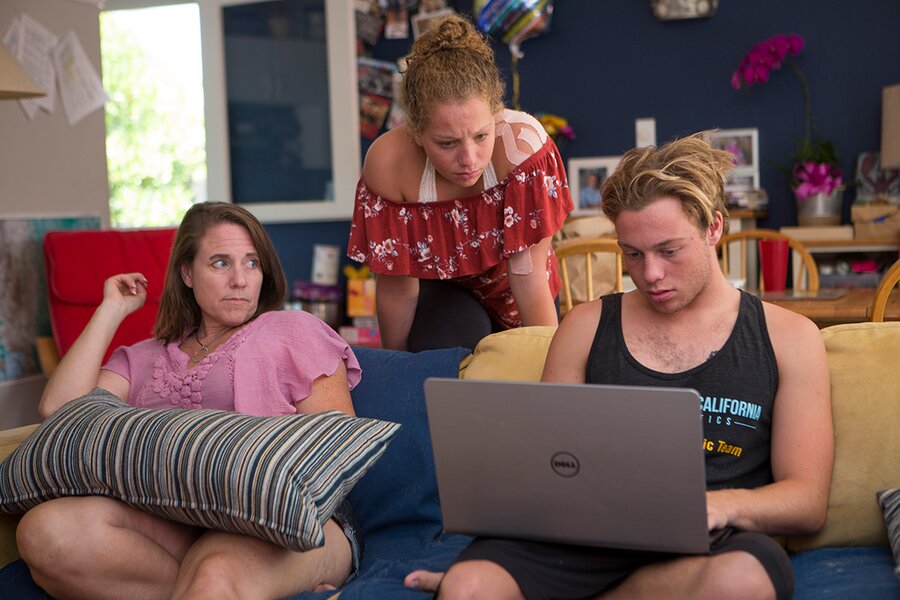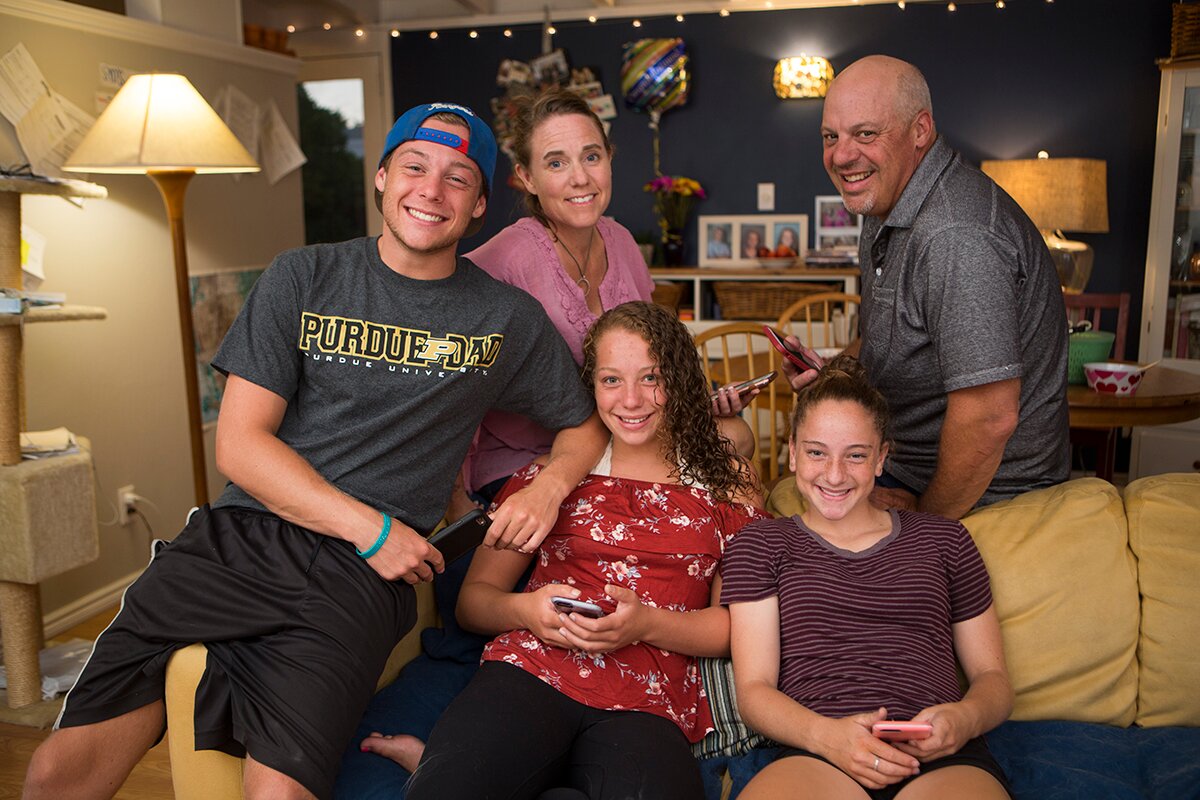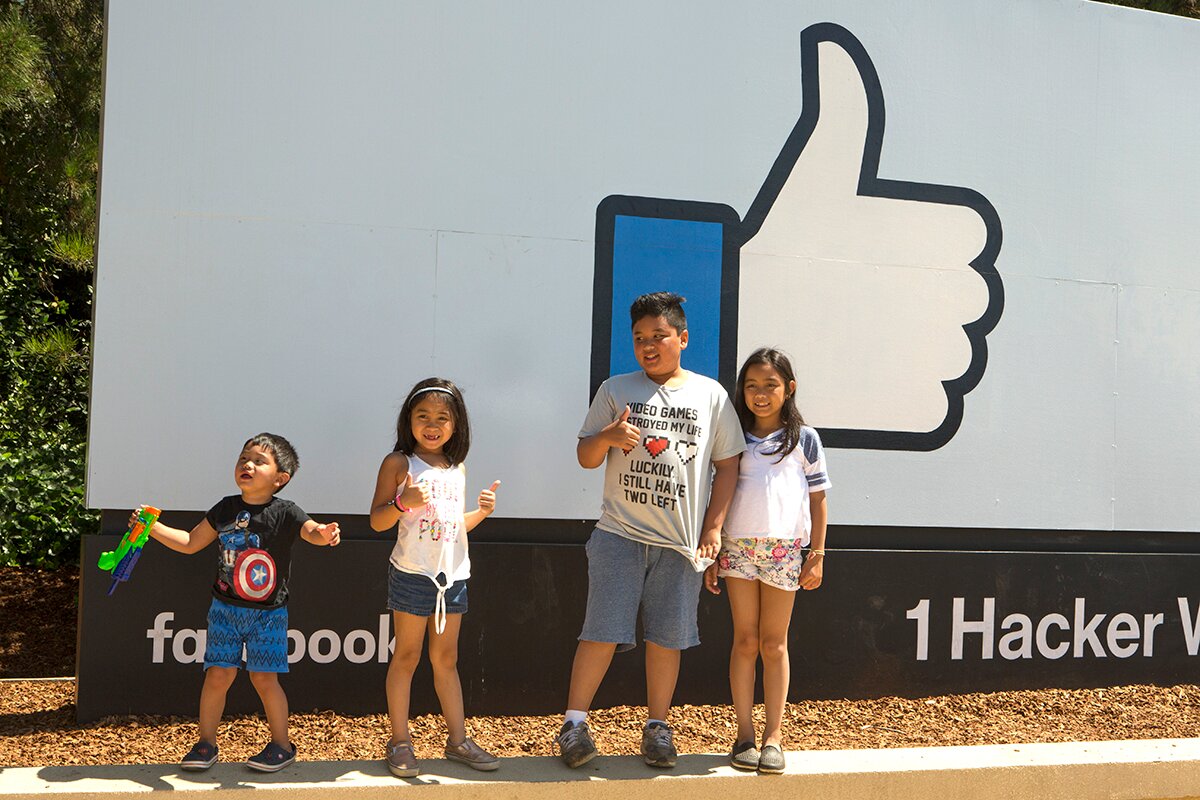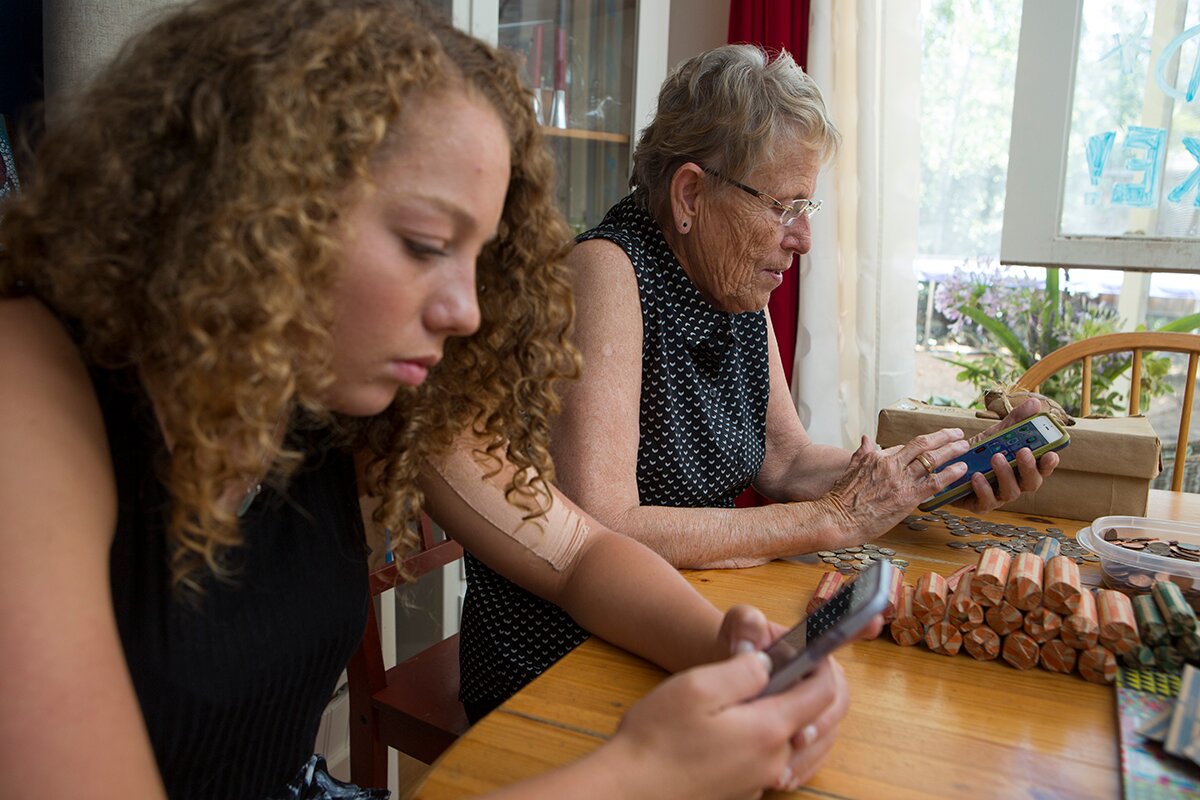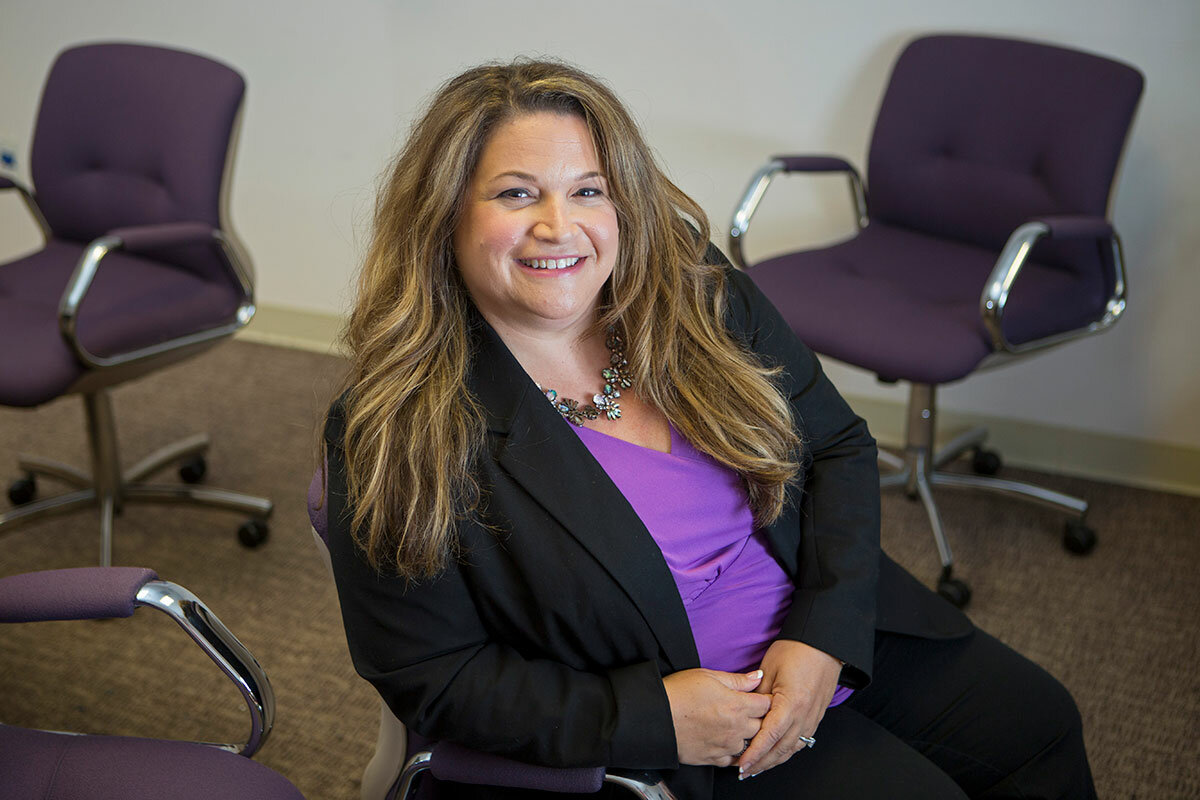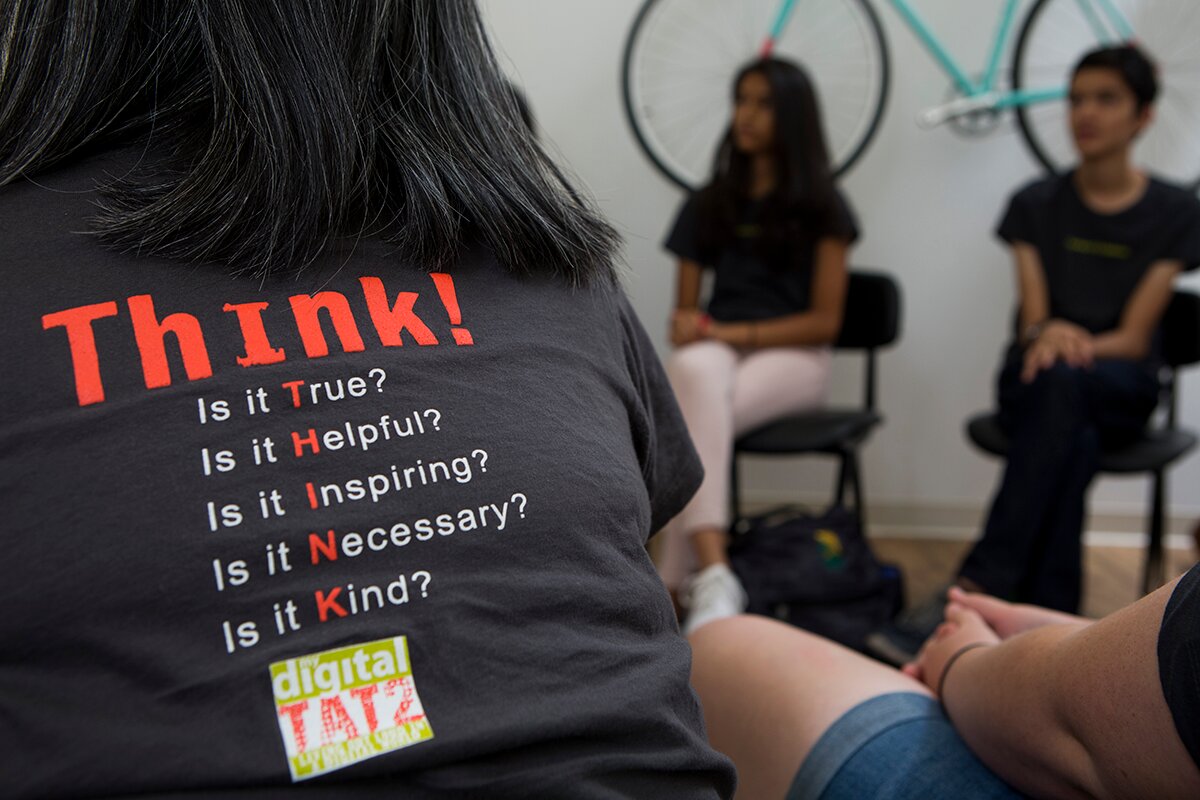Can you please talk, not text? Parenting the Instagram generation
Loading...
| MOUNTAIN VIEW, CALIF.
Jake Lee, a tanned California teenager in baggy shorts and a T-shirt, is lounging on the floor of his parents’ midcentury home. They live in a suburban Silicon Valley enclave of tech workers, cyber-savvy kids, and the occasional Google self-driving car that whirs past along pristine, eucalyptus-lined streets. He flicks through his iPhone, his fingers moving with the speed and dexterity of a jazz pianist, as he answers the sporadic text message.
“I’m on social media every waking moment of my life,” he says, with no particular pride. “I could be, like, Snapchatting and Instagram messaging the same person at the same time.”
Equidistant between the headquarters of Apple and Facebook, two of the world’s biggest tech companies, the Lee household is something of a petri dish for the way technology has altered American family life. Since it debuted the device a decade ago, Apple has sold more than 1.2 billion iPhones.
Facebook reached the mark of 2 billion users per month in June. Together, both companies have shaped an entire generation of young people tethered to their devices.
The three Lee teens – Jake, age 18; Sydney, 16; and Maddi, 13 – all have iPhones. They consume a steady diet of social media. Selfies, hashtags, emojis, YouTube celebrities, and memes fill their days and nights. They’re admitted jocks – water polo and soccer players – so they have only so much time to stare at screens. But it’s still a big part of their lives.
Maddi sticks mostly to Instagram, the photo-sharing app. “Facebook is for old people,” she says. Sydney has 574 Instagram followers but says she’s not as obsessed as many of her friends. She prefers Snapchat, the popular image messaging app, because “that’s just where all my friends are.” In addition to Instagram, Jake had a brief flirtation with the dating app Tinder. This ended when his mom made him delete it.
Like most kids, they’ve had missteps. Jake sheepishly admits to getting in trouble for saying things he shouldn’t have – usually to girls or while joking with friends. There was the time Sydney posted a photo of herself on Instagram in a sports bra. It didn’t seem like a big deal at the time; after all, she’s a swimmer and lifeguard. But drama ensued. One of Jake’s friends noticed and sent him the photo, saying, “Oh, dude, look at what your sister sent me!” It became a thing. “She was humiliated and cried,” says Vickie Lee, the Lee teens’ mom, who perpetually lectures her kids on the potential hazards of social media.
Earlier this year, she hosted a parents’ class on technology and safety at Maddi’s Los Altos, Calif., charter school. She’s keenly aware that a wrong move – a misguided text, an inappropriate photo, a harmful or angry chat – can have devastating consequences. These days, she says, “technology is part of your sex, drugs, and rock ’n’ roll talk you have with your kids.”
Her big concern is that there’s no delete button once something goes out on social media. An embarrassing picture can haunt a teen for what might seem like a lifetime. “There are times in your life when you want to redefine yourself,” she says. “And with social media, you can’t redefine yourself. Your past just follows you around.”
Vickie and her husband, Jody, are trying to do what most parents in the United States – and perhaps the world – are trying to do: raise their kids responsibly in the era of Snapchat and Instagram. Can it be done – can kids today be persuaded to actually talk rather than text? Can they be encouraged to let go of the virtual world – occasionally – and engage in the real one? Can they stop posting selfies long enough – please! – to think of someone else?
The answer is yes. But there are bound to be some anxious moments for parents along the way, and teens have a few things to say about what grown-ups don’t get.
Today, getting a smartphone is a rite of passage for American tweens and teens. It’s arguably more important to them than having a driver’s license or voting (50 percent of eligible Americans between ages 18 and 29 voted in November 2016, while 98 percent of people in the US between 18 and 24 own smartphones).
Signing up for Instagram, which is owned by Facebook, is another milestone. It’s often the beginning of kids’ digital self-expression, and the way they stay connected with friends. Downloading Snapchat, the wildly popular app that lets users exchange messages and images that self-destruct within seconds, is the digital equivalent of the first date – that moment of freedom when kids begin a life without parents listening in.
Those two apps are now the most popular among teens. Seventy-six percent of Americans ages 13 to 17 use Instagram and 75 percent use Snapchat, according to a recent poll from The Associated Press-NORC Center for Public Affairs Research. But the ubiquity of social media doesn’t mean kids begin their digital journey knowing how to navigate the complexities of constant connectivity. There’s no guidebook. There are often few limits. Social media doesn’t come with training wheels – for kids or parents.
As a result, sometimes kids get it right and sometimes wrong. Really wrong.
The news is full of troubling stories about teens and technology. In July, reports surfaced about a mysterious online game called the Blue Whale Challenge in which several apparent participants killed themselves, some broadcasting their suicides online. Across the country, police have busted up groups of middle-schoolers swapping nude photos of underage female classmates. Intense cases of cyberbullying have led to victims taking their own lives. And the web is often especially cruel to young girls, subjecting them to sexism, misogyny, and harassment.
In her book “American Girls: Social Media and the Secret Lives of Teenagers,” Vanity Fair writer Nancy Jo Sales describes the dark side of the digital world. “The culture of social media churns away, seeming to pay very little attention, so far, to the protestations of feminists or anyone who objects to its troubling aspects. And girls suffer. On a daily, sometimes hourly basis on their phones, they encounter things which are offensive and potentially damaging to their well-being and sense of self-esteem.”
All of that’s deeply disturbing. But even though the troubling parts of digital life garner the most media attention, causing panic among parents, it’s not what’s happening on most kids’ devices. Teens will more likely see smiling or goofy selfies, an endless string of heart emojis, or some funny or banal comment. Even though it’s through a filter of technology, which can seem more like an appendage than an appliance, the connections kids seek are deeply human and normal, say experts. Researchers, for instance, talk about the psychological boost kids get when they receive “likes” on their posts and photos.
“There’s a culture of wanting to say nice things online,” says Mia Freund Walker, a family therapist in Redwood City, Calif., and the former executive director of My Digital TAT2, a group formed in 2012 that works with teens on developing responsible digital habits.
For most teens, technology has become so omnipresent that there’s no separating digital life from real life. It’s all intertwined. In many ways, Rose Beardmore’s Instagram is typical of a lot of other kids’. It’s full of smiling friends, flowers, clouds, purple night skies, and the beach. The comments on her 29 posts are punctuated with hearts, smiley faces, and compliments.
“THIS IS SO CUTE,” wrote one of her friends. Most are of this variety: “THIS PHOTO IS GREAT .” For Rose, a 14-year-old from Lunenburg, Mass., Instagram is the idealized version of herself. She limits it to “all my photos that look good.”
Like many other teenage girls, she maintains another account just for her closest friends, known as a “fake Instagram” or “finsta.” That’s where “I update people. I post pictures that aren’t that pretty,” she says. It includes sillier or more candid shots. “The real [Instagram account] is a lot more manicured. It’s not the mirror image of the person who owns it; it’s the prettier twin.”
It’s not uncommon for girls to begin cultivating or shaping their identities this way. On social media, they can decide what kind of image they portray to different communities. “You can curate this perfected image of yourself,” says Havi Wolfson Hall, a clinical social worker and therapist in Palo Alto, Calif. “We always want to present our best selves.” Technology just accelerates that basic human desire, she says, making it happen at a rapid speed and on an astonishing scale.
Inside her office at Parents Place, part of Jewish Family and Children’s Services, a poster asks kids: “How are you feeling today?” The choices come in yellow emoji faces – happy, sad, embarrassed, silly. Ms. Hall operates in an upscale part of the city – around the corner from private preschools, a Pilates studio and spa, and a Whole Foods. Many of the families she treats work in the tech sector across Silicon Valley.
Of course, some of them are building the very devices that get kids and adults hooked on screens to begin with. Yet they are worried about the lasting effects of technology on their children, too. The late Apple chief executive officer Steve Jobs once told a New York Times reporter that his kids hadn’t used an iPad. “We limit how much technology our kids use at home.” But all too often, Hall says, parents who complain that their kids are addicted to social media have trouble controlling their own technology use. “Nine out of 10 times, the kids are learning from their parents,” she says.
The tech industry has become incredibly adept at figuring out how to keep kids using their products. Companies such as Facebook and Snapchat are well aware that young people are naturally wired to share, seeking validation from friends in the form of “likes” and comments.
According to Common Sense Media, a nonprofit that aims to help guide kids and parents through today’s media landscape, the average teen spends nine hours a day consuming media for enjoyment, most of which is on a screen. And tweens (ages
8 to 12) use media almost seven hours a day.
The power inherent in the industry was on full display recently at VidCon, a glitzy five-day conference in Anaheim, Calif., that brought together many of the world’s biggest tech companies and the most recognizable figures on social media. “Influencers,” as they’re known in industry-speak, may only be internet famous but they are a powerful lure to keep kids staring at their screens. VidCon was full of tweens and teens eager to see their favorite internet celebrities.
Amel and Abby, both age 15, from Pasadena and Glendale, Calif., respectively, wanted to see YouTube personalities Joey Graceffa (a longtime video blogger and reality TV star with 7.9 million YouTube subscribers) and Liza Koshy (an actress with 10.3 million subscribers). The video-sharing site has become a powerful cultural force among teens. Ninety-six percent of teenagers use the platform, according to the AP-NORC poll, and 78 percent said they visited YouTube at least once a day.
“I either follow celebrities or YouTube celebrities or friends,” says Abby, pulling out her phone to display her Instagram profile. “I don’t usually follow strangers; I feel like there’s no point and it’s kind of weird.”
Amel follows “idols, celebrities, my friends. I also follow people who inspire body empowerment, who send a message of just ‘love your body, no matter what.’ ” They’re both regularly on YouTube, Instagram, and Snapchat.
“Sure, I’ll get mad if someone unfollows me,” says Amel. “Like, what? Why did you unfollow me?” But, she says, she doesn’t start “crying on the floor” if it happens.
The culture of online celebrity has also spawned a growing number of otherwise average – and nonfamous – families who have essentially taken to filming much of their daily lives and posting it to YouTube. These so-called vloggers are vying for celebrity status on the web, and the advertising dollars that can come from amassing millions of subscribers. The 12 top-earning YouTube stars of 2016 collected a total of more than $70 million.
Presley Alexander, age 12, and her dad, Brian, launched their YouTube channel ActOutGames in 2012. Today, they have more than 20,000 subscribers. To date, they’ve posted a video every day for four straight years. On vacation once at the Great Sand Dunes National Park & Preserve in Colorado, Mr. Alexander drove 45 minutes to get a cellphone signal.
Posting your family’s life on the web for the world to see – and comment on – may seem extreme to many people, but Brian says it doesn’t mean he’s a lenient parent. “I’m that dad who’ll read her Skype sometimes,” he says. “I’ll listen to her conversations, and if she’s saying something weird I’ll be like, ‘Hey, what are you talking about?’
“We are super involved and pay attention to what’s happening,” he notes. “Just because we’re on there doesn’t mean that we’ve ceded this ground.”
Indeed, experts say there are many different ways to be a good digital parent. The key, says Amanda Lenhart, a senior research scientist for AP-NORC who co-wrote the report on kids and social media, is to remember that it’s not “about the technology. It has to be about the values and baseline levels of respect.”
Some parents take a stricter approach in reining in their kids. Aaron Turner of Idaho Falls, Idaho, lets his two teenage daughters, Abby and Katy, use Instagram, but he keeps a close eye on their accounts.
Mr. Turner is a mobile phone security expert. In other words, he knows how to hack smartphones. He uses his knowhow to eavesdrop on whatever his daughters are doing on their phones. If they download an app that’s not allowed – he’s outlawed Snapchat – he’ll know about it.
“My clear message to my daughters that I’m watching their feeds and looking at their private content has served as a protection to them,” says Turner. “When boys start a conversation that may be heading the wrong direction, they just tell them, ‘My dad looks at this,’ and that nips stuff in the bud.”
There was the time, though, that Abby got curious about Snapchat. “I just downloaded it because my friends were using it,” she says. “Everyone has Snapchat.”
It didn’t stay on her phone long. Her dad quickly noticed and deleted it.
Still, Turner is a big believer in the power of social media. He travels a lot for his computer security work and it helps him stay connected with his family. And even he admits you can’t control what kids will do or say – or see – on social media.
“In this new world, there’s no such thing as control. There’s coaching, and there’s monitoring,” he says. “If you’ve raised good kids this is not an issue. Technology does not change your standards and values.”
Other parents place a premium on talking to their kids about social media rather than curtailing their use of devices and apps. The Lees of Silicon Valley, for instance, don’t have rules about having
iPhones at the dinner table. Their approach is to make the kinds of conversations they have on their devices part of their normal family conversations at home, in the car going to swim practice, or while they’re on vacation. They prioritize openness about social media over erecting a virtual fence.
But there may be limits to how much their kids will share with them. Jake will be starting college this fall at Purdue University in West Lafayette, Ind. He’s already told his mom they won’t be friends on Snapchat. Now that he’s about to become a college freshman, it’s not the place for talking to moms, he told her.
Jake’s declaration of independence points up another truism about social media use: At some point, kids have to decide for themselves where to draw the digital line.
Some are already pulling back from total immersion. In her most recent research, Ms. Lenhart found that at least 58 percent of teens who use social media were curtailing their time online, in part because of parental strictures but also because they simply wanted a break.
Those findings reflect what the founders of My Digital TAT2 have seen, too. “They’ll have tech-free zones,” says Gloria Moskowitz-Sweet, a licensed social worker and one of the cofounders of the group. “We are seeing kids come up with their own rules and regulations.”
Still, when you talk to teens, almost all dispute their parents’ assumptions that social media has become their entire world in the first place. They chafe at the assertion that teens prefer digital connections to personal ones. For instance, Rose, the 14-year-old from Massachusetts, says she’s constantly chatting with her friends about hanging out #IRL (in real life). “We’ll keep saying, ‘I can’t wait to see you. To hug you.’ We like face-to-face communication more,” she says. “[Parents] tend to think that the importance of [social media] in our lives is inherently a bad thing. It’s called social media for a reason.”
After Ms. Sales’s book on girls and social media came out in 2016, alarming parents nationwide, Ms. Moskowitz-Sweet co-wrote a piece in the San Francisco Chronicle that aimed to counter that fear. “Our kids are living out loud in a digital culture,” she wrote. “Social media naturally heightens the challenges associated with adolescence. Teens are telling us they want parents to trust their use of social media and give them freedom to explore, take risks, and make mistakes.”
Dangers do exist online, of course. But experts say the key is not to overreact and place too many restrictions on technology. It’s far better to understand social media and how children are actually using it. As John Palfrey and Urs Gasser put it in their book, “Born Digital: How Children Grow Up in a Digital Age”:
“[As] a culture of fear emerges around the online environment, we must put these real threats into perspective; our children and future generations have tremendous opportunities in store for them, and not in spite of the digital age, but because of it.”




